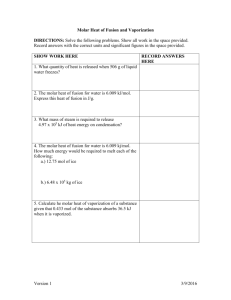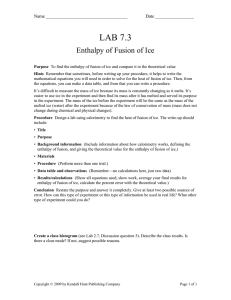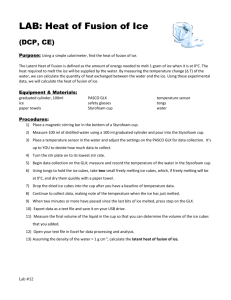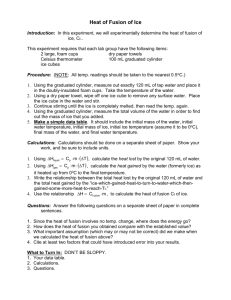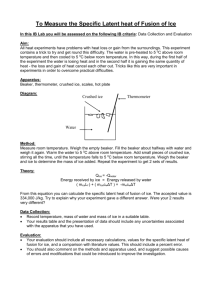Heat of Fusion for Ice (Temperature Sensor)
advertisement
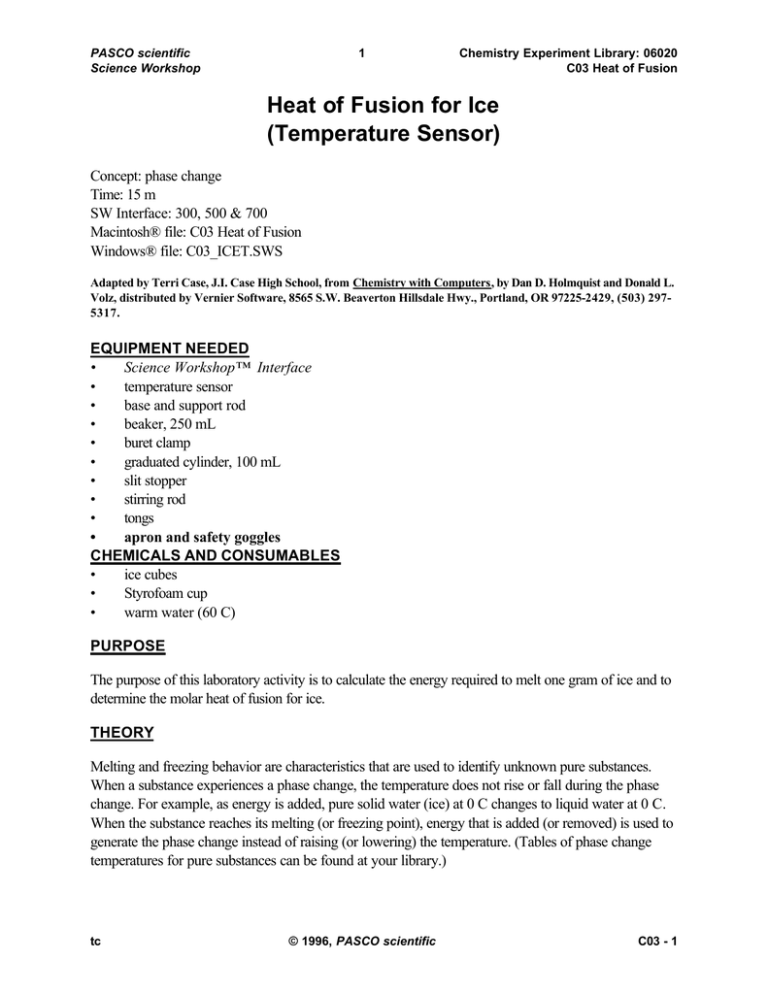
PASCO scientific Science Workshop 1 Chemistry Experiment Library: 06020 C03 Heat of Fusion Heat of Fusion for Ice (Temperature Sensor) Concept: phase change Time: 15 m SW Interface: 300, 500 & 700 Macintosh® file: C03 Heat of Fusion Windows® file: C03_ICET.SWS Adapted by Terri Case, J.I. Case High School, from Chemistry with Computers, by Dan D. Holmquist and Donald L. Volz, distributed by Vernier Software, 8565 S.W. Beaverton Hillsdale Hwy., Portland, OR 97225-2429, (503) 2975317. EQUIPMENT NEEDED • Science Workshop™ Interface • temperature sensor • base and support rod • beaker, 250 mL • buret clamp • graduated cylinder, 100 mL • slit stopper • stirring rod • tongs • apron and safety goggles CHEMICALS AND CONSUMABLES • ice cubes • Styrofoam cup • warm water (60 C) PURPOSE The purpose of this laboratory activity is to calculate the energy required to melt one gram of ice and to determine the molar heat of fusion for ice. THEORY Melting and freezing behavior are characteristics that are used to identify unknown pure substances. When a substance experiences a phase change, the temperature does not rise or fall during the phase change. For example, as energy is added, pure solid water (ice) at 0 C changes to liquid water at 0 C. When the substance reaches its melting (or freezing point), energy that is added (or removed) is used to generate the phase change instead of raising (or lowering) the temperature. (Tables of phase change temperatures for pure substances can be found at your library.) tc © 1996, PASCO scientific C03 - 1 PASCO scientific Science Workshop 2 Chemistry Experiment Library: 06020 C03 Heat of Fusion Therefore, to calculate a heat of fusion you must measure a _T of a surrounding material. In this experiment you will measure the temperature change of a beaker of water as the ice in the beaker melts. To calculate the heat that flows from the water, you can use the relationship q = Cp• m• _T where q stands for heat flow, Cp is specific heat, m is mass in grams, and _T is the change in temperature. For water, Cp is 4.18 J/g C. SAFETY PROCEDURES Follow all safety directives given by your teacher. PROCEDURE For this activity, the temperature sensor measures the temperature of ice water. The Science Workshop program records and displays the data. PART I: Computer Setup 1. Connect the interface to the computer, turn on the interface, and turn on the computer. 2. Connect the DIN plug of the temperature sensor to Analog Channel A on the interface. 3. Open the Science Workshop file titled as shown; Macintosh:C03 Heat of Fusion Windows:C03_ICET.SWS • The document will open with one Table and one Digits display. • Note: For quick reference, see the Experiment Notes window. To bring a display to the top, click on its window or select the name of the display from the list at the end of the Display menu. Change the Experiment Setup window by clicking on the “Zoom” box or the Restore button in the upper right hand corner of that window. 4. The "Sampling Options…" for this experiment are: Periodic Samples = Slow at one measurement per 10 seconds and Stop Condition = Time at 500 seconds. PART II: Sensor Calibration and Equipment Setup • tc You do not need to calibrate the temperature sensor. The temperature sensor produces a voltage that is proportional to temperature (10 mV = 1.0 Celsius). The default calibration is 110.000 C = 1.100 V and -10.000 C = -0.100 V. If you would like to calibrate the temperature sensor, please refer to the Operations section of the User's Guide. © 1996, PASCO scientific C03 - 2 PASCO scientific Science Workshop 3 Chemistry Experiment Library: 06020 C03 Heat of Fusion 1. Use a base and support rod, a buret clamp and a slit stopper to support the temperature sensor as shown. 2. Place a Styrofoam cup into a 250 mL beaker. 3. Pour 100.0 mL of water at about 60 C into the Styrofoam cup. 4. Obtain 7 or 8 large ice cubes. 5. Lower the temperature sensor into the warm water (to about 1 cm from the bottom). Temperature Sensor Slit stopper Styrofoam cup Beaker . Heat of Fusion for Ice PART III: Data Recording: 1. Click the "REC" button to begin recording temperature data. 2. Wait until the temperature reaches a maximum (it will take a few seconds for the sensor to reach the temperature of the warm water). This maximum will determine the initial temperature, T1, of the water. 3. As soon as this maximum temperature is reached, fill the Styrofoam cup with ice cubes. 4. Shake excess water from the ice cubes before adding them (or dry with a paper towel). 5. Record the maximum temperature, T1, in your data table. 6. Use a stirring rod to stir the mixture as the temperature approaches 0 C. Important: As the ice melts, add ice cubes to keep the mixture cold. 7. When the temperature reaches about 4 C, quickly remove the unmelted ice (using tongs). 8. Continue stirring until the temperature reaches a minimum (and begins to rise). This minimum temperature is the final temperature, T2, of the water. tc © 1996, PASCO scientific C03 - 3 PASCO scientific Science Workshop 4 Chemistry Experiment Library: 06020 C03 Heat of Fusion 9. Record T2 in your data table. 10. Click the "STOP" button to stop recording data. 11. Use the 100-mL graduated cylinder to measure the volume of water remaining in the Styrofoam cup to the nearest 0.1 mL. Record this as V2. ANALYZING THE DATA 1. Click the "Statistics" button ( temperature values. ) in the Table display to check your minimum and maximum 2. Subtract T2 - T1 to determine _T, the change in water temperature. 3. Calculate the volume of ice that was melted (V2 –V1). 4. Find the mass of ice melted (use 1.00 g/mL as the density of water). 5. Calculate the energy (in joules) released by the 100 g of liquid water as it cooled (q = Cp •m•_T). 6. Now calculate the heat of fusion, the energy required to melt one gram of ice (in J/g H2O). 7. Use your answer to Step 6 and the molar mass of water to calculate the molar heat of fusion for ice (in kJ/mol H2O). DATA TABLE: HEAT OF FUSION Item Value Initial water temperature, T1 (C) C Final water temperature, T2 (C) C Change in water temperature, _T (C) C Final water volume, V2, (mL) mL Initial water volume, V1, (mL) mL Volume of melt, (mL) mL Mass of ice melted g Heat released by cooling water (q = Cp •m•_T) J J/g J/g ice melted (heat of fusion) kJ/mol ice melted (molar heat of fusion) tc © 1996, PASCO scientific kJ/mol C03 - 4 PASCO scientific Science Workshop 5 Chemistry Experiment Library: 06020 C03 Heat of Fusion % Percent difference QUESTION 1. What is your percent difference for the molar heat of fusion value? (The accepted value for molar heat of fusion is 6.01 kJ/mol.) Remember, percent difference = tc accepted - measured accepted © 1996, PASCO scientific × 100 % C03 - 5
